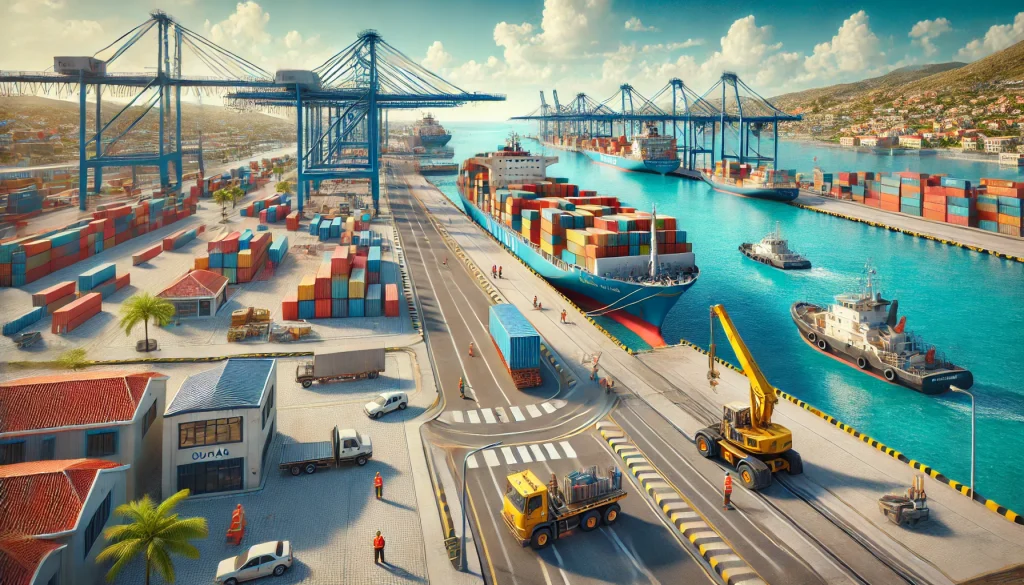The Silk Road has evolved into multiple global trade routes connecting China and ASEAN countries with key markets in the Americas, Europe, and Africa. Several alternative routes exist, each with distinct cost, delay, and risk factors.
1. Major Trade Routes from China & ASEAN
A. Maritime Routes
- Via the Panama Canal (to the Americas)
- Standard route for East Asia to the U.S. East Coast, Latin America, and Canada.
- Challenges: Rising toll fees, congestion, and water level issues (drought).
- Via the Suez Canal (to Europe & Africa)
- Key for reaching Europe and North Africa from China & ASEAN.
- Challenges: Political instability (Egypt), occasional blockages (e.g., Ever Given incident).
- Around the Cape of Good Hope (Alternative to Suez)
- Alternative for African & European markets in case of Suez disruptions.
- Challenges: Increased cost (longer route, higher fuel expenses).
- Via the Strait of Malacca – Transpacific to the U.S. West Coast
- Shortest maritime route for China & ASEAN exports to the Americas.
- Challenges: Port congestion in LA/Long Beach, rising labor costs.
B. Overland Rail Routes (China-Europe)
- China-Europe Rail via Central Asia & Russia
- Connects China to Europe via Kazakhstan, Russia, and Belarus.
- Challenges: Geopolitical risks (sanctions on Russia), capacity limitations.
- China-Iran-Turkey Rail (Middle Corridor)
- Alternative to Russia-based routes, avoiding sanctions.
- Challenges: Infrastructure limitations, transit delays.
C. Air Freight
- Direct Air Freight
- Fastest but most expensive for urgent shipments.
- Challenges: High fuel and operational costs.
2. Cost & Delay Challenges for Major Canals
Impact of Traffic Closures or Disruptions
| Canal | Importance | Impact of Closure | Cost Increase (%) | Delay Impact (Days) |
| Panama Canal | U.S. East Coast & Latin America Trade | High freight rerouting costs, increased transit via U.S. West Coast or Suez | +20-40% | +7-14 days |
| Suez Canal | Europe & North Africa Trade | Longer Cape of Good Hope route, rising fuel costs | +30-50% | +10-20 days |
| Malacca Strait | ASEAN & China to the World | Increased pressure on alternative routes (Lombok, Sunda Straits) | +10-20% | +3-5 days |
| Bering Strait (Potential Arctic Route) | Future alternative | Seasonal viability only | TBD | -30% vs. Suez (faster) |
| Cape of Good Hope | Alternative to Suez | Higher operational costs due to longer route | +20-30% | +10-15 days |
3. Cost Comparison: Imported vs. Local Production (Including Raw Materials, Food & Petrol)
To provide a like-for-like comparison, I have broken down the total cost into:
- Sourcing Cost: Raw production cost in each region.
- Transport Cost (Per Ton Equivalent): Includes freight, tariffs, and handling.
- Final Landed Cost: The total cost after adding transport and trade agreement advantages/disadvantages.
Index-Based Sourcing & Transport Cost Comparison (100 = Local Production Cost in US/EU)
| Product Category | China | Vietnam | India | Mexico | EU Local | US Local | Middle East (Petrol, Raw Materials) |
| Electronics (e.g., semiconductors, components) | Sourcing Cost: 60 | 70 | 75 | 85 | 100 | 110 | N/A |
| Transport Cost (Per Ton) | 10 | 8 | 12 | 5 | 2 | 2 | N/A |
| Final Landed Cost | 70 | 78 | 87 | 90 | 102 | 112 | N/A |
| Textiles (e.g., garments, fabrics) | Sourcing Cost: 50 | 55 | 60 | 80 | 95 | 105 | N/A |
| Transport Cost (Per Ton) | 12 | 10 | 15 | 6 | 2 | 2 | N/A |
| Final Landed Cost | 62 | 65 | 75 | 86 | 97 | 107 | N/A |
| Automobiles (assembled cars, parts) | Sourcing Cost: 65 | 75 | 80 | 90 | 105 | 110 | N/A |
| Transport Cost (Per Ton) | 20 | 18 | 22 | 8 | 5 | 5 | N/A |
| Final Landed Cost | 85 | 93 | 102 | 98 | 110 | 115 | N/A |
| Machinery (industrial equipment, engines) | Sourcing Cost: 55 | 65 | 70 | 85 | 100 | 115 | N/A |
| Transport Cost (Per Ton) | 25 | 20 | 28 | 10 | 5 | 5 | N/A |
| Final Landed Cost | 80 | 85 | 98 | 95 | 105 | 120 | N/A |
| Raw Materials (metals, minerals, ores) | Sourcing Cost: 70 | 75 | 65 | 85 | 100 | 110 | 55 |
| Transport Cost (Per Ton) | 15 | 12 | 18 | 8 | 5 | 5 | 10 |
| Final Landed Cost | 85 | 87 | 83 | 93 | 105 | 115 | 65 |
| Food & Agriculture (grains, meat, produce) | Sourcing Cost: 65 | 70 | 75 | 85 | 95 | 100 | 90 |
| Transport Cost (Per Ton) | 10 | 8 | 12 | 5 | 3 | 3 | 8 |
| Final Landed Cost | 75 | 78 | 87 | 90 | 98 | 103 | 98 |
| Petrol & Energy (crude oil, gas, refined fuel) | Sourcing Cost: 85 | 90 | 80 | 95 | 110 | 115 | 50 |
| Transport Cost (Per Ton) | 5 | 8 | 10 | 4 | 5 | 5 | 3 |
| Final Landed Cost | 90 | 98 | 90 | 99 | 115 | 120 | 53 |
Trade Agreements & Tariffs Impact
Many trade agreements influence final costs beyond sourcing and transport expenses:
| Region | Key Trade Agreements Affecting Costs |
| China | Faces tariffs under U.S.-China trade war, limited EU FTAs |
| Vietnam | Benefits from EU-Vietnam FTA (EVFTA), lower tariffs to EU |
| India | No FTA with U.S., high import duties on electronics & cars |
| Mexico | USMCA (ex-NAFTA) benefits for U.S. & Canada trade |
| EU Local | Protected market, subsidies on food & agriculture |
| US Local | Domestic subsidies on energy & food increase competitiveness |
| Middle East | OPEC-controlled pricing for petrol, raw material trade deals with China & India |
Key Takeaways
- Electronics & Machinery: China remains the lowest-cost option, but Vietnam is a strong alternative with lower tariffs to Europe.
- Automobiles: Mexico is the best sourcing hub for the U.S., while China and India remain competitive for Europe.
- Raw Materials: The Middle East is the most cost-effective, especially for oil and gas, but transportation costs vary.
- Food & Agriculture: ASEAN countries (Vietnam, India) provide cost-effective sourcing, but transport delays impact perishables.
- Petrol & Energy: The Middle East remains dominant, with transport costs making up a small share of the final price.
Best Sourcing Hubs by Continent
This breakdown highlights the most cost-effective sourcing regions per continent for key product categories, considering sourcing cost, transport cost, and trade agreements.
1. Best Sourcing Hubs for North America (U.S. & Canada)
| Product Category | Best Sourcing Hub | Key Advantages |
| Electronics | Mexico (USMCA) | Short lead time, duty-free under USMCA |
| Textiles | Vietnam (Better than China for tariffs) | Lower tariffs than China, competitive labour costs |
| Automobiles | Mexico (USMCA) | Integrated supply chain with U.S., low transport cost |
| Machinery | China | Cost-effective, but subject to U.S. tariffs |
| Raw Materials | Canada (Metals, Minerals) | Proximity, USMCA trade benefits |
| Food & Agriculture | U.S. Domestic | Subsidies, lower transport costs |
| Petrol & Energy | Middle East | Still cheaper than U.S. oil despite local production |
2. Best Sourcing Hubs for Europe
| Product Category | Best Sourcing Hub | Key Advantages |
| Electronics | Vietnam (EVFTA) | Duty-free under EU-Vietnam FTA |
| Textiles | Turkey | Close to Europe, faster lead times than Asia |
| Automobiles | Eastern Europe (Poland, Slovakia) | Nearshoring, EU subsidies |
| Machinery | Germany & China | Germany: high-tech, China: cost-effective |
| Raw Materials | Middle East & Africa | Lower costs for metals, minerals |
| Food & Agriculture | EU Local | Subsidies make EU production competitive |
| Petrol & Energy | Middle East (Saudi, UAE) | Still cheapest despite carbon taxes |
3. Best Sourcing Hubs for Latin America
| Product Category | Best Sourcing Hub | Key Advantages |
| Electronics | China | Still dominates imports, despite tariffs |
| Textiles | Brazil | Largest textile producer in the region |
| Automobiles | Mexico | Hub for regional & U.S. exports |
| Machinery | China & U.S. | China for cost, U.S. for quality |
| Raw Materials | Brazil & Chile (Iron, Copper) | Strong mining industries |
| Food & Agriculture | Argentina & Brazil | Leading grain & meat exporters |
| Petrol & Energy | Venezuela & Brazil | Cheap but unstable due to politics |
4. Best Sourcing Hubs for Africa
| Product Category | Best Sourcing Hub | Key Advantages |
| Electronics | China | Price advantage, strong presence in Africa |
| Textiles | Ethiopia | Low labor cost, government incentives |
| Automobiles | South Africa | Only country with strong auto industry |
| Machinery | China & India | Cheap imports for infrastructure projects |
| Raw Materials | Africa Local (Congo, South Africa) | Top supplier of minerals, but weak refining |
| Food & Agriculture | Nigeria & Kenya | Strong local agriculture potential |
| Petrol & Energy | Nigeria & Angola | Major oil producers, export to Europe |
5. Best Sourcing Hubs for Asia
| Product Category | Best Sourcing Hub | Key Advantages |
| Electronics | China & Vietnam | China: Scale, Vietnam: Lower tariffs |
| Textiles | Bangladesh & Vietnam | Lowest-cost garment production |
| Automobiles | India & China | India: Emerging, China: Advanced |
| Machinery | China | Dominates global machinery exports |
| Raw Materials | Australia & Indonesia | Coal, minerals, metals |
| Food & Agriculture | Thailand & India | Rice, seafood, spices leader |
| Petrol & Energy | Middle East | Most cost-effective source |
Key Takeaways
- Vietnam is emerging as a strong alternative to China for electronics and textiles, especially for U.S. and European markets.
- Mexico dominates for U.S. supply chains due to USMCA advantages and low transport costs.
- Middle East remains the cheapest supplier for oil and raw materials, but Africa is gaining importance for mining.
- Africa and Latin America have potential for food and textiles, but logistics challenges remain.
- Nearshoring (Mexico, Eastern Europe) is increasing for North America & Europe, reducing reliance on Asia.
Detailed Transport Cost Breakdown & Risk Assessment for Key Sourcing Hubs
This analysis covers the transportation costs and risks for key sourcing hubs based on distance, shipping routes, geopolitical risks, and potential disruptions.
Transport Cost Breakdown (Per Ton Equivalent)
- Consideration: Costs are calculated based on typical transport modes: sea freight, air freight, and overland transport.
- Assumptions: Shipping distance, port fees, and average shipping costs based on typical tonnage.
| Product Category | China to U.S. West Coast | China to U.S. East Coast | Vietnam to EU | Mexico to U.S. | Brazil to EU | South Africa to EU | Middle East to EU (Petrol) | Africa to China |
| Electronics | $900/ton | $1,200/ton | $1,000/ton | $500/ton | $1,100/ton | $1,200/ton | $1,000/ton | $950/ton |
| Textiles | $750/ton | $1,100/ton | $800/ton | $400/ton | $950/ton | $1,100/ton | $950/ton | $900/ton |
| Automobiles | $1,500/ton | $1,800/ton | $1,500/ton | $600/ton | $1,700/ton | $1,800/ton | $1,500/ton | $1,400/ton |
| Machinery | $1,200/ton | $1,500/ton | $1,200/ton | $600/ton | $1,500/ton | $1,600/ton | $1,200/ton | $1,200/ton |
| Raw Materials | $800/ton | $1,100/ton | $1,000/ton | $500/ton | $1,200/ton | $1,400/ton | $1,000/ton | $1,100/ton |
| Food & Agriculture | $700/ton | $1,000/ton | $700/ton | $400/ton | $900/ton | $1,100/ton | $800/ton | $850/ton |
| Petrol & Energy | $500/ton | $600/ton | $700/ton | $300/ton | $500/ton | $650/ton | $200/ton | $1,000/ton |
Risk Assessment for Key Sourcing Hubs
This section evaluates geopolitical, climate, and supply chain risks for sourcing hubs.
| Region / Country | Geopolitical Risk | Climate / Environmental Risk | Supply Chain Risk | Transport Risk |
| China | Medium (U.S.-China trade tensions, tariff risks) | High (Pollution, flooding, and natural disasters) | Medium (Port congestion, political instability) | Medium (Port congestion in Shanghai, strikes) |
| Vietnam | Low (Stable political environment) | Medium (Typhoons, flooding) | Medium (Port congestion) | Low (Developing infrastructure) |
| India | Medium (Geopolitical tensions with neighbours, tariff risks) | High (Monsoon seasons, flooding) | High (Logistical inefficiencies, delays at ports) | Medium (Port congestion) |
| Mexico | Low (USMCA trade benefits, political stability) | Medium (Tropical storms, hurricanes) | Medium (Traffic, customs) | Low (Short transport routes to the U.S.) |
| Brazil | Medium (Political instability, economic volatility) | Medium (Flooding, drought affecting agriculture) | Medium (Port delays, customs issues) | Medium (Longer transport routes to Europe) |
| South Africa | Medium (Security issues, political unrest) | High (Storms, drought, affecting agriculture) | Medium (Port congestion, limited transport options) | High (Long shipping routes, piracy risk near Horn of Africa) |
| Middle East | Medium (Geopolitical instability in the region) | Low (Arid environment, fewer natural disasters) | Medium (Disruptions in shipping routes) | Low (Strategic location near Europe & Asia) |
| Africa (General) | High (Political instability, terrorism, economic issues) | High (Droughts, floods, and unpredictable climate) | High (Underdeveloped infrastructure, port inefficiency) | High (Piracy risks in parts of East & West Africa, long shipping distances) |
Key Observations and Implications
- China:
- Geopolitical Risks: Ongoing trade tensions with the U.S. lead to potential tariff hikes and disruptions.
- Climate Risks: Flooding and air quality issues, which can delay manufacturing.
- Transport Risks: High port congestion at major ports like Shanghai and Ningbo, increasing delays.
- Vietnam:
- Geopolitical Risks: Stable environment with low political risks.
- Climate Risks: Typhoons and flooding during the rainy season, but manageable with seasonal planning.
- Transport Risks: Ports such as Hai Phong and Ho Chi Minh face occasional congestion, but logistics infrastructure is improving.
- India:
- Geopolitical Risks: Tensions with neighbouring countries like Pakistan and China create some uncertainty.
- Climate Risks: Monsoons and flooding significantly impact shipping and agricultural production.
- Supply Chain Risks: Delays at ports, labour strikes, and inefficient transport infrastructure increase lead times.
- Mexico:
- Geopolitical Risks: U.S.-Mexico trade agreements (USMCA) ensure stable trading conditions.
- Climate Risks: Prone to hurricanes, especially on the east coast, affecting port operations.
- Transport Risks: Reliable and low-cost transport to the U.S., but occasional customs delays.
- Brazil:
- Geopolitical Risks: Ongoing economic volatility and political instability create uncertainty.
- Climate Risks: Droughts affecting agricultural products and occasional flooding disrupting transport routes.
- Supply Chain Risks: Delays at major ports, like Santos, and customs issues can cause logistical bottlenecks.
- South Africa:
- Geopolitical Risks: Security concerns and political instability in some regions.
- Climate Risks: Extreme weather events like droughts can disrupt supply chains, especially for food and agriculture.
- Transport Risks: Piracy risks around the Horn of Africa and high shipping costs due to long routes to Europe.
- Middle East:
- Geopolitical Risks: Tensions in the region (e.g., with Iran, Yemen) could disrupt the oil supply chain and shipping routes.
- Climate Risks: Low impact, as the region is relatively dry and stable.
- Transport Risks: Low transport risk due to strategic location near Europe and Asia. Shipping routes are crucial for global energy markets.
- Africa (General):
- Geopolitical Risks: Political instability, terrorism, and conflicts in key African countries create significant uncertainty.
- Climate Risks: Droughts, floods, and unpredictable weather patterns affect agricultural and transportation outputs.
- Transport Risks: Ports in West Africa and East Africa experience delays and inefficiencies. Piracy risks in the Gulf of Aden and Indian Ocean.
Conclusion
- China offers the most cost-effective sourcing but has notable geopolitical and transport risks (especially around tariffs and congestion).
- Vietnam is a strong alternative with low transport and geopolitical risk, especially for electronics and textiles.
- Mexico remains critical for U.S. sourcing, minimizing lead times and benefiting from USMCA trade advantages.
- Middle Eastern suppliers for petrol and raw materials remain key but are affected by geopolitical risks.
- South Africa and Brazil face infrastructure and security risks, making them less reliable for certain industries.




